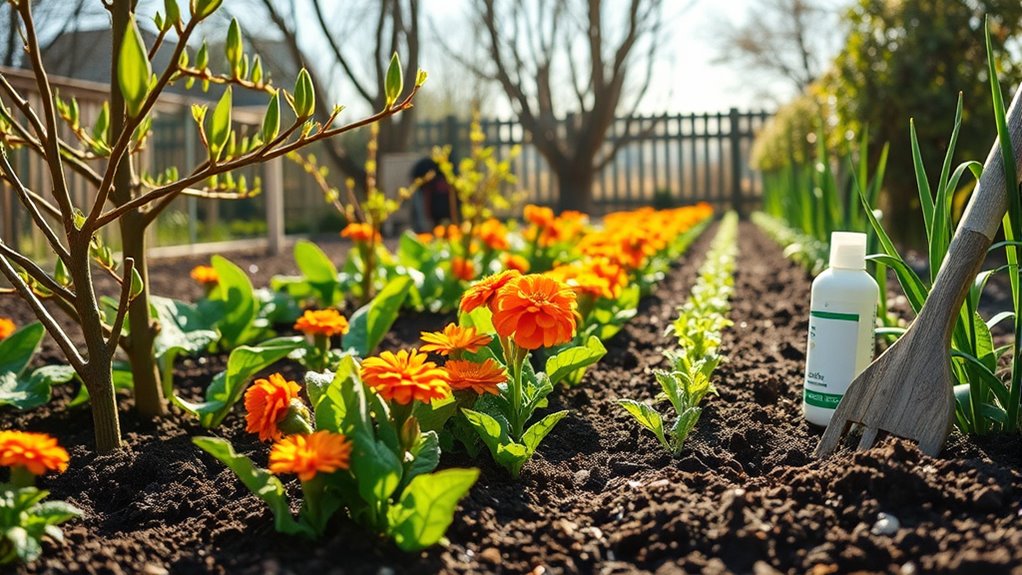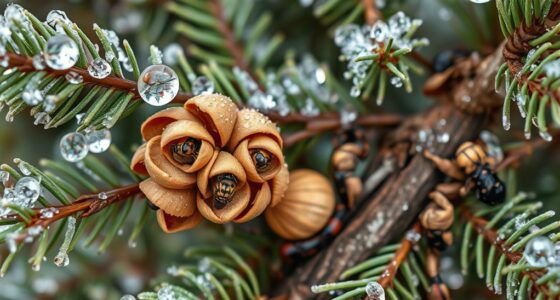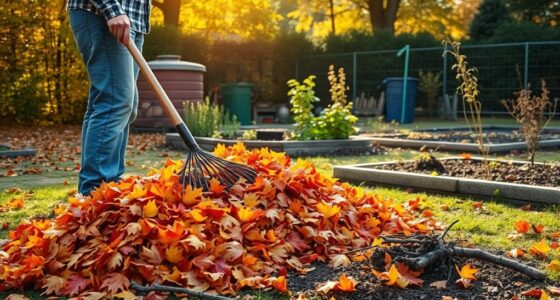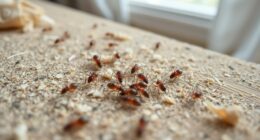To prevent pests early in spring, start by cleaning up debris and removing diseased plants to eliminate hiding spots. Inspect and repair garden structures like fences and trellises to keep pests out. Apply organic treatments such as neem oil or insecticidal soap before pests appear. Mulch to deter critters and plan companion planting with pest-repelling herbs. Keep an eye on pests and record sightings—this will help you spot patterns and improve your defenses all season long.
Key Takeaways
- Maintain garden cleanliness by removing debris and diseased plants to eliminate pest habitats.
- Inspect and repair garden structures to prevent pest entry and hiding spots.
- Apply organic pest preventatives like neem oil and mulch to deter pests early.
- Utilize companion planting strategies, such as marigolds and basil, to naturally repel pests.
- Regularly monitor for pests and keep detailed records to track infestation patterns and treatment effectiveness.
Clean Up Debris and Remove Diseased Plants
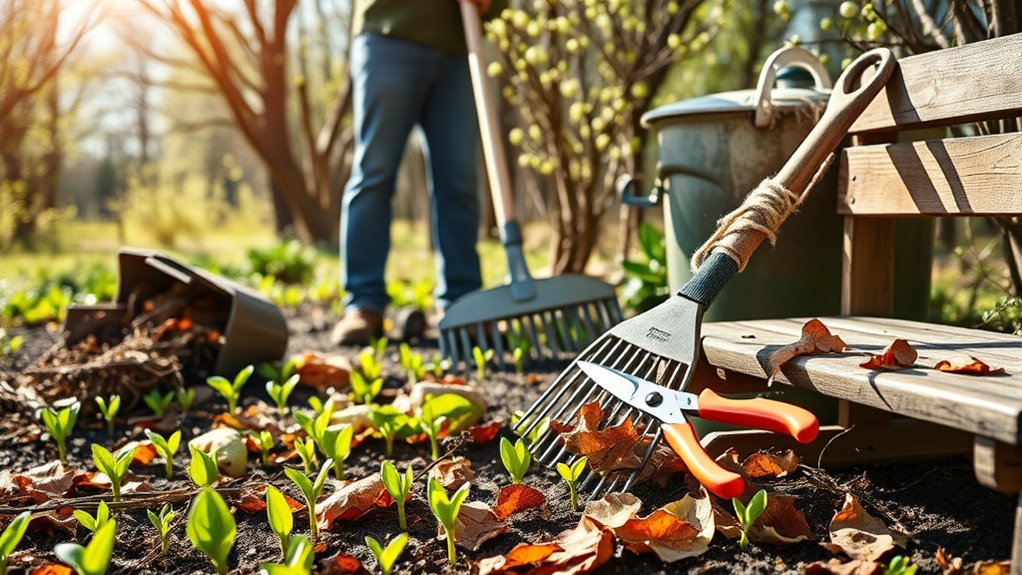
To prevent pests from taking hold in your garden, it’s essential to start by cleaning up debris and removing diseased plants. Garden waste, such as fallen leaves, old stems, and broken branches, creates hiding spots for pests and encourages disease spread. By clearing this debris, you reduce pest habitats and make your garden less attractive to insects and rodents. Additionally, inspect plants carefully and remove any diseased plants immediately. Diseased plants can harbor pests and pathogens that spread quickly if left unchecked. Properly disposing of these plants and garden waste prevents pests from thriving and helps maintain a healthy, pest-resistant garden environment. Regular cleanup ensures pests don’t establish a foothold early in the season, giving your garden a strong start. Using appropriate controls can further enhance your pest prevention efforts.
Inspect and Repair Garden Structures
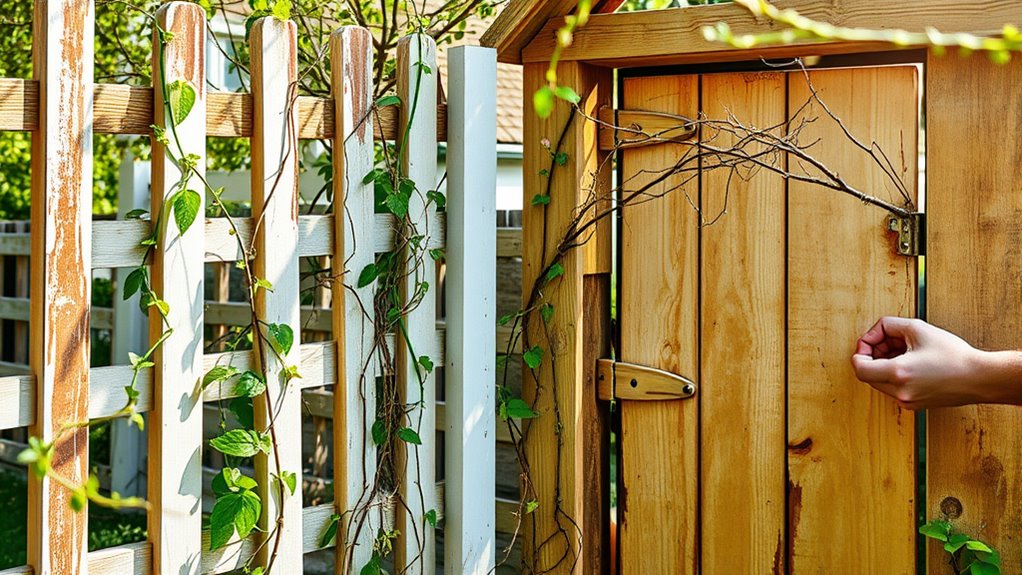
Start by carefully checking all your garden structures for any signs of damage or instability. Reinforce supports where needed to keep plants secure and prevent pests from hiding. Finally, clean and clear around these structures to eliminate hiding spots and improve airflow. Additionally, inspecting for damage or instability can help identify potential entry points for pests and ensure your garden remains healthy.
Check for Damage
Inspecting your garden structures for damage is an essential step in pest prevention, as compromised fences, trellises, and sheds can provide hiding spots for pests or allow entry points into your garden. Conduct a thorough damage assessment to identify weak spots or broken areas that need repair. Look for signs of pest activity, such as gnaw marks or nests, which can indicate pest identification issues. Repair any broken or loose boards, tighten loose hardware, and seal gaps to prevent pests from entering. Regular inspections help catch problems early before pests establish permanent shelter. Properly maintained structures reduce hiding spots, making your garden less inviting for pests. Staying vigilant ensures your garden remains healthy and pest-free throughout the season. Additionally, understanding alimony laws and property division could be beneficial if you encounter legal issues related to property damage or disputes during your garden maintenance.
Reinforce Supports
Reinforcing your garden supports is a proactive way to keep pests at bay. Start by inspecting stakes, trellises, and cages for any signs of wear or instability. Stake reinforcement ensures plants stay upright, preventing them from falling over and creating hiding spots for pests. Check trellis stabilization to make sure structures are secure and won’t collapse under the weight of growing plants. Tighten loose connections and replace damaged parts to maintain support strength. Properly supported plants are less likely to become stressed or damaged, reducing pest attraction. Reinforcing supports early in spring keeps your garden organized and pest-resistant throughout the growing season. Regular maintenance also prevents pests from hiding in crevices or collapsing structures that provide shelter. Additionally, understanding self-watering plant pots can help you choose the best containers to support healthy, pest-resistant plants.
Clean and Clear
To keep your garden pest-free, it’s essential to regularly clean and repair your garden structures. Inspect fences, trellises, and raised beds for damage or debris that can harbor pests. Fix any broken or loose parts to maintain garden aesthetics and prevent pest hiding spots. Clear out old plant debris and ensure structures are stable to promote healthy plant growth and soil enrichment. Properly maintained structures also improve airflow, reducing humidity that attracts pests. Consider sealing gaps or cracks to prevent pest entry. Regular cleaning prevents pest buildup and keeps your garden looking tidy. By maintaining your garden structures, you create a less hospitable environment for pests and support overall plant health. Additionally, vertical storage solutions can help organize gardening tools and supplies, reducing clutter and potential pest habitats.
Apply Preventive Organic Treatments
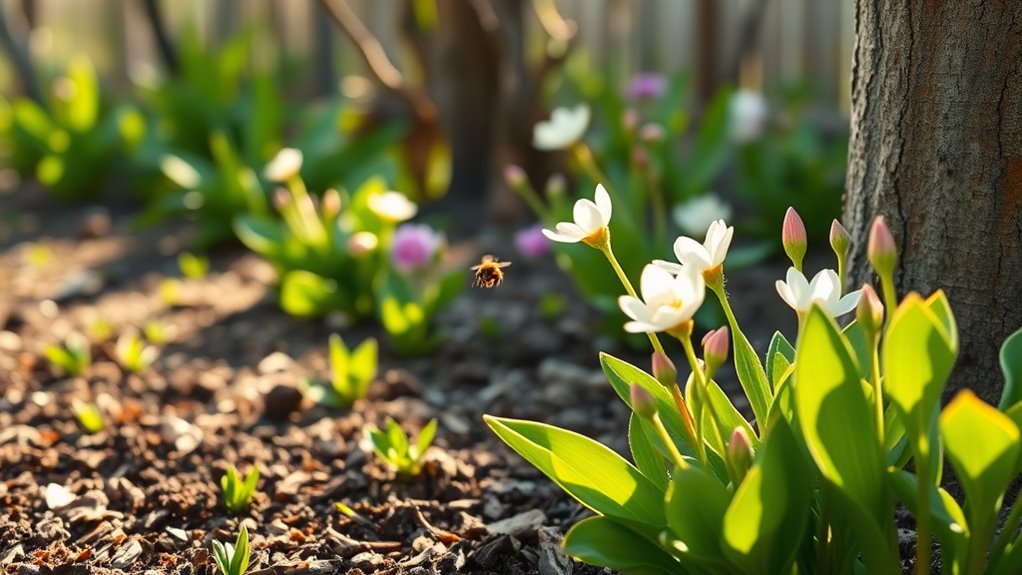
Choosing the right organic pesticides and applying them at the right time is key to protecting your garden. You need to take into account when pests are most active and follow the recommended application methods. Proper timing and technique help ensure your treatments are effective and safe for your plants. Utilizing preventive strategies, such as early intervention and consistent monitoring, can further reduce pest issues.
Organic Pesticide Choices
Organic pesticides offer an effective way to prevent pests from taking hold in your garden without relying on synthetic chemicals. You can choose products based on natural oils or botanical extracts, which target pests while being safer for beneficial insects. These organic options work by disrupting pest feeding or reproduction, providing a proactive shield for your plants. When selecting organic pesticides, consider the following:
- Use neem oil, a natural oil that repels many insects and disrupts their life cycle
- Apply botanical extracts like pyrethrum, derived from chrysanthemums, for quick knockdown
- Opt for insecticidal soaps, which suffocate soft-bodied pests
- Check labels for plant-specific recommendations and environmental safety
- Choosing appropriate application methods can improve effectiveness and reduce potential harm to beneficial insects
These choices help maintain a healthy, balanced garden ecosystem while preventing pest problems early.
Timing and Application
Timing is crucial when applying preventive organic treatments; applying them too early or too late can reduce their effectiveness. You need to focus on timing precision to ensure your treatments target pests when they’re most vulnerable. Apply organic treatments when pests are just beginning to appear or before signs of infestation become severe. Follow specific application methods for each product—whether spraying, soil drenching, or dusting—to maximize coverage and adherence. Weather conditions also matter; apply treatments on calm, dry days to prevent runoff and ensure proper absorption. Consistency is key, so schedule applications at recommended intervals to build a protective barrier. Monitoring pest activity and understanding their life cycle helps optimize timing for treatments. By carefully timing and choosing the right application methods, you enhance your pest prevention efforts and promote a healthier garden.
Plan and Mulch to Discourage Pests

Mulching your garden beds is an effective way to prevent pests from taking hold, as it creates a physical barrier that disrupts pest movement and breeding. Apply mulch at the right depth—about 2-3 inches—to suppress weeds and improve soil health. Incorporate companion planting strategies to naturally repel pests; for example, planting marigolds near vegetables deters nematodes. Choose organic mulch like straw or wood chips to avoid attracting pests. Regularly check mulch for signs of pests or disease, and replenish it as needed. Proper mulching not only discourages pests but also conserves moisture and moderates soil temperature. Understanding the plant properties of the herbs and plants used in companion planting can enhance their pest-repelling effectiveness. Remember, a well-planned mulch layer combined with companion planting enhances your pest prevention efforts effectively.
Start Companion Planting Strategies
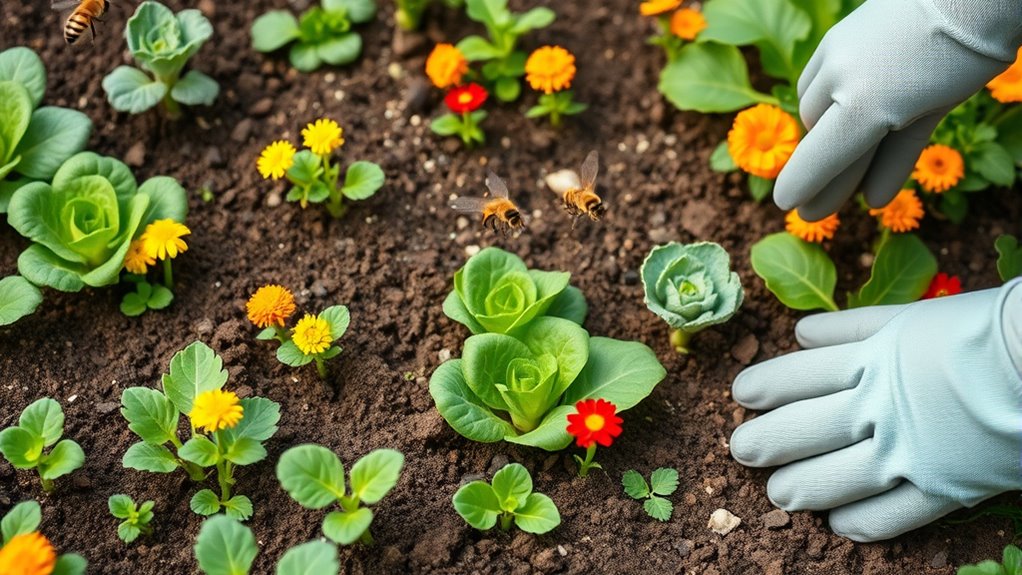
Starting with companion planting strategies can substantially boost your pest prevention efforts. By selecting the right plant combinations, you create natural pest deterrents that protect your garden without chemicals. For example, planting marigolds near vegetables can repel nematodes and aphids, while basil can deter mosquitoes and flies. Companion planting works by confusing pests, masking scents, or releasing natural repellents. It also improves overall plant health, making your garden more resilient. To start, research beneficial plant pairings suited to your climate and garden layout. Incorporating herbs, flowers, and vegetables that naturally ward off common pests can enhance your pest management strategies. Consistent application of companion planting strategies can considerably reduce pest problems and promote a healthy, thriving garden throughout spring.
Monitor and Record Pest Sightings
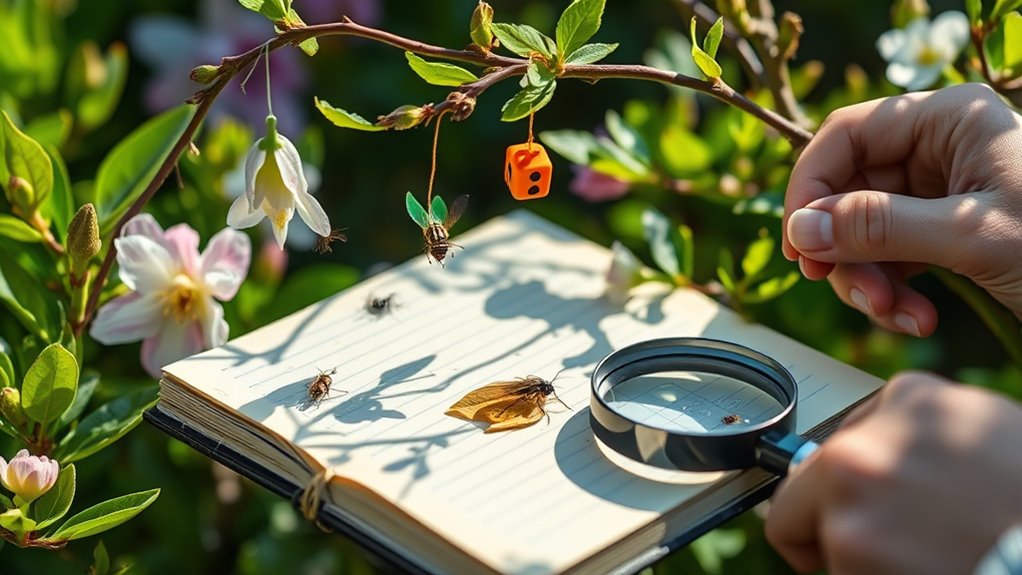
Have you been keeping a close eye on your garden for pests? Monitoring your plants regularly helps you catch issues early. Focus on pest identification by inspecting leaves, stems, and soil for any signs of trouble. Keep detailed records of pest sightings, noting the date, location, and type of pest. This record keeping helps track patterns and assess the effectiveness of your prevention efforts. To deepen your monitoring, consider these tips:
- Use sticky traps or visual guides to identify pests accurately
- Record the growth stage of affected plants during sightings
- Note environmental conditions like weather that may influence pest activity
- Regularly review your pest records to spot recurring problems or seasonal trends
Frequently Asked Questions
When Is the Best Time to Start Spring Pest Prevention?
You should start spring pest prevention as soon as the weather warms up, ideally during your spring cleanup. This is the perfect time to remove debris and prepare the soil, which helps prevent pests from settling in. By doing soil preparation early, you create a healthy environment for your plants and make it harder for pests to invade. Starting early gives your garden a strong defense against pests throughout the season.
How Can I Identify Early Signs of Pest Infestation?
Spotting subtle signs swiftly saves your garden. Look for pest damage signs like chewed leaves, holes, or sticky residue. Use insect identification techniques such as checking under leaves, inspecting stems, and observing plant behavior. Keep a keen eye for tiny pests or eggs, and notice any unusual wilting or discoloration. Early detection helps you act fast, preventing full-blown infestations and protecting your plants’ health.
What Natural Predators Help Control Garden Pests?
You can encourage natural control in your garden by attracting beneficial insects that prey on pests. Beneficial insects like ladybugs, lacewings, and predatory beetles help manage aphids, caterpillars, and other pests naturally. To attract them, plant nectar-rich flowers and avoid broad-spectrum pesticides. By fostering these natural predators, you create a balanced ecosystem that keeps pest populations in check, reducing the need for chemical controls and promoting a healthy, thriving garden.
Are There Specific Plants That Repel Pests in Early Spring?
Think of your garden as a fortress where certain plants act as loyal guards. Companion planting and pest repellent herbs like marigolds, basil, and garlic serve as natural shields against pests in early spring. By planting these strategically, you create a protective barrier that discourages unwanted invaders, allowing your garden to flourish. Embrace these plant allies, and you’ll foster a healthier, pest-resistant garden from the very start.
How Often Should I Monitor My Garden for Pests?
You should monitor your garden for pests regularly, ideally once or twice a week, especially during early spring when pests are most active. Consistent pest monitoring and garden surveillance help you catch infestations early, making control easier. Keep an eye out for damaged leaves, discolored plants, or unusual insects. By staying vigilant, you can respond quickly and prevent pests from causing significant damage to your garden.
Conclusion
By following this early spring garden checklist, you’ll set your garden up for a pest-free season. Think of your efforts as building an impenetrable fortress against pests—they won’t stand a chance! Regular cleanups, smart planting, and vigilant monitoring are your best defenses. Stay proactive, and your garden will flourish with vibrant, healthy plants. With these simple steps, you’ll transform your garden into a thriving paradise that’s almost too perfect to believe!
